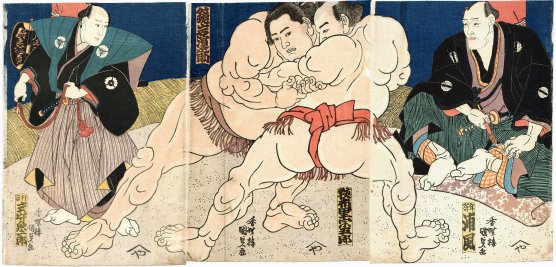 歌川国貞
歌川国貞「相撲」は、直接戦うレスリングの競技の形式です。
“Sumō Sumo
wrestling” is considered a modern “Budō 武道 Martial art”, or
the sport that has a history spanning many centuries.
This
sport originated in Japan, the only country where it is practiced
professionally.
「相撲」には多くの古代の伝統が継承されています。
Many
ancient traditions have been preserved in “Sumō Sumo wrestling”.
Even
today “Sumō Sumo wrestling” includes many ritual elements, such as “Rikishi Sumo
wrestler” use salt for purification on “Dohyō Circular ring” put “Mage 髷 Topknot” on his
head.
Life as
“Rikishi Sumo wrestler” is highly regimented, with rules regulated by the Japan
Sumo Association.
Most “Rikishi
Sumo wrestler” are required to live in communal “Sumō-beya 相撲部屋 Sumo training stables”.
In “Sumō-beya
Sumo training stables”, all aspects of their daily lives—from meals to their
manner of dress—are provided by strict tradition.
In
ancient times, a custom of “sumo” was born as “Shinji 神事Ritual of Shinto” of “Matsuri 祭 Festival” in “Jinja
神社 Shrine”.
In the
Middle Ages, it spread as training of “Kumiuchi 組打ち Tussle” in battle.
“Oda
Nobunaga 織田信長” and other “Sengoku Daimyo 戦国大名 Feudal of the Warring State
Period” held a sumo tournament and hired the winners as soldiers.
Roots of
“Ōzumō 大相撲 Grand Sumo Tournament” trace back to
the “Edo-jidai Period” as a form of sporting entertainment.
“Tomioka
Hachiman-gū 富岡八幡宮Shrine” was the birthplace of “Kanjin
Sumō 勧進相撲 Charity sumo tournament” that was allowed by “Bakufu 幕府 Shogunate”.
In 1684
(Teikyo first), “Tomioka Hachiman-gū Shrine” held “Kanjin Sumō Charity sumo
tournament” for fund raising.
Since
“Fukagawa 深川” was a unloading place near “Edo-wan 江戸湾 Bay”, there must been many men who were proud of their power.
“Kanjin
Sumō Charity sumo tournament” was held for about 100 years before moving to “Ekō-in
回向院 Temple” in 1791.
Currently,
it is held in “Osaka 大阪” in March, “Nagoya 名古屋” in July, and “Fukuoka 福岡” in November.
 歌川国貞
歌川国貞